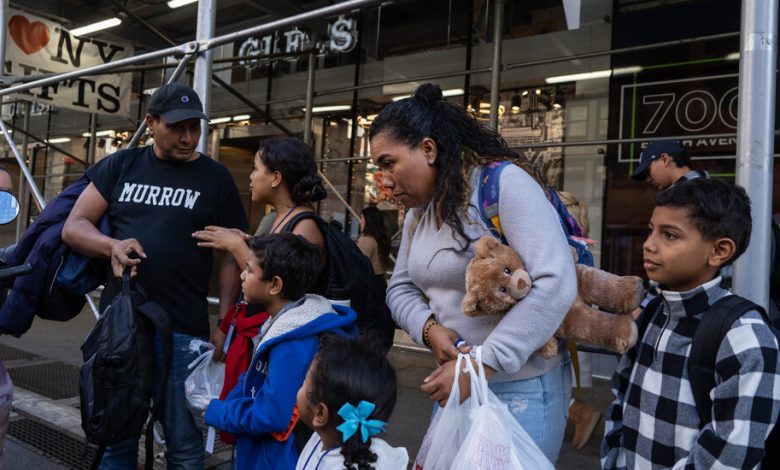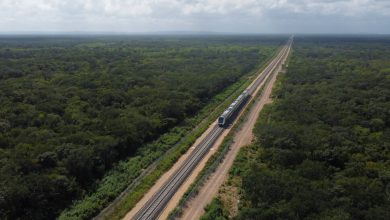New York, Overwhelmed, Toughens Stance on Housing Migrant Families

New York City’s homeless system is sheltering record numbers of people week after week, as an influx of migrants accelerates to its highest rate since the crisis began.
The city is moving more and more migrants out of its vast network of emergency shelters by combining pressure tactics with help in finding permanent housing. But the jump in arrivals — to nearly 4,000 a week — has outpaced those efforts.
So Mayor Eric Adams is now trying a tougher approach. He is taking aim at families with children — the bulk of the migrant population flooding into the city — with measures that may stretch the boundaries of New York’s legal obligation to provide shelter.
On Monday, the mayor announced a 60-day limit on how long a family can stay at any one shelter. After that, the family must return to an intake center and reapply for shelter. A similar limit was imposed on single adults over the summer, and later reduced to 30 days.
“Expanding this policy to all asylum-seekers in our care is the only way to help migrants take the next steps on their journeys,” Mr. Adams said in a statement.
He also said that a new 500-family shelter being built at a defunct Brooklyn airport would not provide families with their own rooms. Instead, there will be an open floor plan with locked privacy dividers between living spaces.
Advocates for homeless people criticized the plan immediately. The Legal Aid Society and the Coalition for the Homeless said in a joint statement that forcing families to move every two months would “disrupt access to education” for the thousands of migrant children who are enrolled in the city’s public schools (federal law lets homeless students stay in the same school if they move, but moving could mean longer commutes). And housing families “in cramped and open cubicles” at Floyd Bennett Field, the former airport, may violate state regulations governing family homeless shelters, the groups said.
The city comptroller, Brad Lander, who has often criticized the mayor’s handling of the migrant crisis, echoed the groups’ concerns.
“Denying families with children the stability of a private room and curtailing their shelter stay is a shortsighted, cruel step,” he said in a statement.
Mr. Adams has been searching desperately for ways to contain the cost of housing and feeding migrants, a figure he has estimated will reach $12 billion over three years. More than 126,000 people fleeing economic and political upheaval, mostly in Latin America, have come to the city since last year. Over 64,000 are now in shelters.
New York has been a magnet for migrants in part because it is the only major U.S. city that must provide a bed for every homeless person who asks for one — the result of a decades-old court case.
During the week ending Oct. 8, about 400 migrants a day were moved out of shelters, a review of city data shows. That number would have made a dent in the population a few months ago. Not any longer. The number of migrants arriving with nowhere to live has nearly doubled since June, from about 300 a day to about 600 a day in the first week of October — the most the city has recorded.
On Oct. 4, the city asked a judge to suspend the so-called right to shelter for single adults. The next day, Mr. Adams left for a trip to Latin America to try to persuade hundreds of thousands of migrants headed north that conditions in New York City might not be as welcoming as they had heard.
“When you see children making the long trek through a jungle and then having to live in conditions of congregate shelters, of not having the real environment that they deserve,” he said in Mexico City, “it just makes it extremely challenging.”
Colleen Putzel-Kavanaugh, an associate policy analyst at the Migration Policy Institute, a research organization, said the increase in migration to New York was most likely linked to increases in crossings at the southern border. CBS News reported that Border Patrol agents had apprehended 210,000 people last month between official ports of entry along the Mexican border, up from 180,000 in August and more than double the 99,000 apprehended in June.
In early October, many migrants interviewed in Mexico, Ecuador and Colombia said the mayor’s warnings about life in New York would not dissuade them from coming, although some said they were headed elsewhere after friends told them jobs and housing were scarce in the city.
At a hotel shelter in Queens where she has lived since May, Viviana Verde said on Monday that if she were transferred to a shelter with less privacy, she would find a way to leave the system instead.
“I just can’t imagine going to a place with many more families,” said Ms. Verde, 36, who migrated from Venezuela with her husband and gave birth to a daughter last month.
But Ms. Verde said she did not know how she and her husband would be able to afford rent. They are eligible to get working papers but need $1,500 for a lawyer to process the documents, she said. Her husband has been working a little fixing motorcycles outside the shelter, she said, “but almost all the money we earn, we spend on food and things for the baby.”
Speaking on Tuesday outside the Row NYC hotel, a large family shelter in Midtown Manhattan, Javier Tovar, 28, was dismayed to hear about the 60-day rule.
“We want to get out of here, but we need time,” said Mr. Tovar, who did construction work in Venezuela and came to the United States with his wife and three children a month ago.
“If they give us 60 days in the shelter, well, it will be God’s will, but there is a lot of confusion and worry,” he added. “We are already afraid that they will deport us since we only recently entered the country.”



